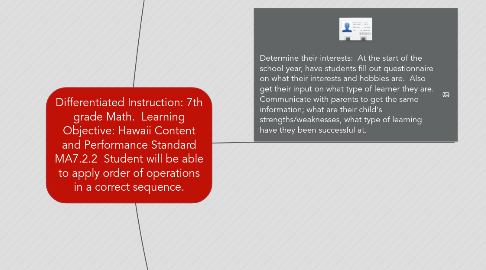
1. Determine their interests: At the start of the school year, have students fill out questionnaire on what their interests and hobbies are. Also get their input on what type of learner they are. Communicate with parents to get the same information; what are their child's strengths/weaknesses, what type of learning have they been successful at.
2. Elizabeth
2.1. Profile: Elizabeth is very energetic and happy. She enjoys listening to music, drawing pictures for her friends, and hanging out with her friends joking around. She has difficulty focusing on school work and touches people (physically touching them). She will refuse to do her school work. She sometimes will not enter the classroom and waits outside until "caught" by an adult. She is self-consious and doesn't like to be seated with boys or students she feels don't like her. (She has some diagnosed emotional problems. She has an IEP as well as a behavior plan.) She is in a math workshop class and has inclusion teachers assisting her in English and Science.
2.1.1. Learning the order of operations will require a special learning environment for Elizabeth. She will need to be seated next to students who do not make her anxious. She will need specific instructions and examples on the board before beginning her own problems. She will need reminders of appropriate behavior and written targets for proper behavior.
2.1.1.1. STRATEGIES
2.1.1.2. 1. Computer program Think Through Math. Elizabeth can work at her own pace with ear phones on. This will keep distractions to a minimum. She can do 1 lesson at a time which should take less than 15 minutes.
2.1.1.3. 2. Elizabeth can do a short worksheet of practice problems, not more than 10. She is able to work with others so she can participate in group work on the 10 problems.
2.1.1.4. 3. PEMDAS foldable. Because Elizabeth likes artisitic projects, making a colorful foldable will help to reinforce the order of operations as well as give her an artistic outlet. This foldable will be kept in her math notebook and can be used for quizzes and tests.
2.1.1.5. 4. Elizabeth does enjoy working with other students and could participate in a group project which involves planning a party. She and her group could choose the menu of 5 snack items and 2 beverages, look up the prices of items using the laptops, and create a spreadsheet of all the party items. The order of operations will be important in finding the overall budget. Each group could present this to the class once the menu is planned.
3. Isaiah
3.1. Profile: Isaiah loves sports, especially football. He wants to be a professional football player when he grows up. He also likes music, dancing and singing. He has difficulty focusing on school and a short attention span. He is not cooperative with adults and does not like school. He is failing most of his classes and does not feel successful. He does desire to pass his classes as his dad punishes him if he fails. (He has diagnosed ADHD as well as a low IQ. He is in a math workshop class and has inclusion teachers assisting him in English and Science.)
3.1.1. Learning the order of operations will require a monitored environment for Isaiah. He needs to be seated away from the students who distract him. Since he works well when he is alone, a private seating area might be appropriate, as long as it doesn't make him feel singled out. (This could be offered to him so that he can choose to sit at his own table if he wants.)
3.1.1.1. STRATEGIES
3.1.1.2. 1. Isaiah would benefit from a graphic organizer which organizes the order of operations. The teacher could map out the information for the graphic organizer on the board and students can then transfer the information to their own graphic organizer in their math notebook, which can be used for future assignments/tests.
3.1.1.3. 2. Isaiah will be able to understand the order of operations more fully if he can apply it to a real life situation. He would enjoy doing a football team manager project involving ordering football uniforms with different sizes and prices. A spreadsheet with the information would be provided and he would take the information needed and calculate the amount of money it would take to order new univorms for the team. Designing the team jersey could be part of this assignment to keep it fun and creative.
3.1.1.4. 3. Since Isaiah really loves listening to music, a trial of doing the online program Think Through Math could be offered along with listening to music at the same time. If Isaiah could agree to keep working on the lessons while listening to music, it could be a benefit that he earns while doing the practice assignmets.
3.1.1.5. 4. Isaiah likes to learn visually so a video on real life order of operations as well as instructional videos would be helpful. There are Khan Acadamy videos for instruction and videos which show real life order of operations available on YouTube and other websites. This could be shown to the entire class as it will probably benefit others too.

